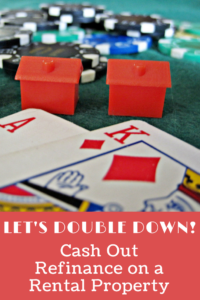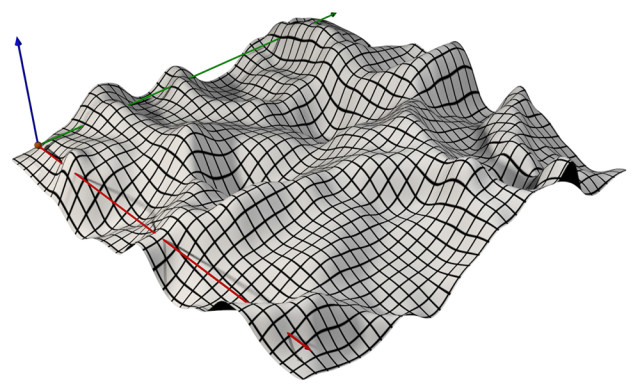Oops, I did it. I upset the internet masses last week.
I asked if it made sense to refinance my investment property in Atlanta to use the money, combined with a little of my own, to purchase a new rental (see Let’s Double Down! Cash Out Refinance on a Rental Property for the analysis).
The reader comments include “I would not refinance for a measly 17k” and “I would be very concerned about needing to borrow $15k to make a purchase”.
Both true. Valid points. I asked for opinions and that’s what I got.
However this isn’t where the analysis ends. Let’s dig a little bit deeper.
Reviewing Investment Property Refinance Basics
Imagine a property with a $45k mortgage that is worth $100k. It has $55k of equity, or 55%.
The return on investment doesn’t really change if I have 20%, 55%, or 85% equity. Either way it has the same cash flow and appreciation benefit.
A cash out refinance is basically starting a brand new mortgage with only 25% equity. There is a fee to do the refinance and you get the difference in cash.
For the example with $55k in equity on a $100k house, the new mortgage balance would be $25k. If the fee is $3k, you would get to pocket $27k. Untaxed. Lump sum.
This is why it is important for people to do their research into mortgage refinancing from websites like sebastianfriedman.com so that they are equipped to move onto this stage at the right time to align correctly with their finances. That said, besides gaining knowledge regarding mortgage refinancing from websites, it would also be a good idea to talk to a certified mortgage broker who might have more in-depth knowledge regarding the same. Wondering how to find them? For instance, if you are from Etobicoke, Canada, then looking up keywords like CMB Etobicoke on the Web can help you find them easily.
The Power of the Cash Out Refi
The cash out refinance can be a powerful way to more quickly build up your portfolio of rentals. You can take that $27k and use it as a down payment on a new investment property.
Just like that, Property 1 clones itself and creates Property 2. Then seven years down the line, after slowly building equity, perhaps you do it again: Property 1 clones itself and creates Property 3. Property 2 clones itself and creates Property 4.
Same initial investment, but after 7 years it has turned into four properties!
The Patient Alternative Approach
Rather than doing a cash out refinance, you can certainly leave the equity in the house. Once the equity gets to 100%, you no longer have a mortgage to pay and the cash flow is much greater.
If you want to buy more rental properties with this approach, you have to do it the old fashioned way – save your money for a down payment!
There’s nothing wrong with this approach, but it will take much much longer to get to 4 properties (or whatever number of rentals you are shooting for).
More importantly, it will also take much longer to hit whatever cash flow goal you have to be financially independent.
Viewing My Rental Properties as a Portfolio
I want to go about rental property investing as would a portfolio manager. All proceeds are reinvested to grow the portfolio. I also contribute an additional $1000 a month to save up for more investments.
The goal is to optimize the portfolio so it makes the most money in the long-run. How do I do it?
I actually sat down and ran some numbers over 10 years.
Here is the complete spreadsheet with all the calculations. Disclaimer: this is a rough model
The Inputs
Start with my portfolio now (a property in Atlanta purchased in 2011 and a property in Memphis purchased in 2014) and $10k in cash. Contribute $1k per month to the portfolio for the first 5 years. Assume the cash flow from each property is $167 per month, principle pay down is $100 per month, and appreciation is 3% per year.
Each new property purchased will be 20% down for a $100k property. With $3k in closing costs and $2k added to cash reserves for unexpected repairs, let’s assume each new property requires $25k in cash. A refinance will cost $3k.
The calculations also won’t go beyond 10 properties (although the spreadsheet includes notes when additional properties can be added).
The Scenarios
Even though the model isn’t perfect, it should help compare different strategies – the relative numbers is what matters, not that it is a perfect calculation.
Scenario 1: Never Refinance
This approach is to just use the cash flow and $1k per month contribution to build the portfolio.
Scenario 2: Refinance only for a full property
This approach is to wait until a property has enough equity built up that it can be used to purchase a complete new property. With the assumptions, it takes 53% equity in order to get the $28k required ($20k down payment, $6k fees for refi + new mortgage, $2k in reserves). It takes almost 8 years to build up that much equity.
Scenario 3: Refinance now and for a full property
This is the approach I was asking about in last week’s article. Refinance now when Property 1 is at 44% equity, then from now on, wait until each property has 53% equity to refinance.
Scenario 4: Refinance aggressively at 40% equity
Rather than waiting to get to 53% equity, what if I refinanced every time a property reached 40% equity? With the given assumptions, it takes just under 6 years to get to the refinance rather than 8.
The Results
It should come as no surprise that doing cash out refinances will significantly improve the results.
Scenario 1: Never Refinance
- Purchase 5th property after 3 years 8 months
- Will have 9 properties after 10 years
- After 10 years, the portfolio value is $434,750
Scenario 2: Refinance only for a full property
- Purchase 5th property after 2 years 5 months
- Purchase 10th property after 7 years 5 months
- After 10 years and stopping at 10 properties, the portfolio value is $509,067
- Could purchase another 5 properties if I wanted, or put $53,667 in cash to work in another way
Scenario 3: Refinance now and for a full property
- Purchase 5th property after 2 years 9 months
- Purchase 10th property after 6 years 10 months
- After 10 years and stopping at 10 properties, the portfolio value is $505,217
- Could purchase another 4 properties if I wanted, or put $70,167 in cash to work in another way
Scenario 4: Refinance aggressively at 40% equity
- Purchase 5th property after 2 years 9 months
- Purchase 10th property after 5 years 10 months
- After 10 years and stopping at 10 properties, the portfolio value is $542,950
- Could purchase another 7 properties if I wanted, or put $97,300 in cash to work in another way
Interpreting the Data
It should come as no surprise that doing cash out refinances will drastically improve the results over 10 years.
The ending portfolio value is very similar in Scenario 2 and 3. The only difference between those scenarios is whether or not to refinance Property 1 now, so perhaps it doesn’t matter either way.
However, if I were to continually refinance at 40% equity, it would lead to a substantially better result. This jump is comparable to the jump from not refinancing at all to refinancing at 53% equity.
So in conclusion…
I still don’t know that there is a conclusion yet.
If I have a set number of properties I would like to get to, it is a good idea to refinance aggressively.
If I want to keep adding properties past 10, it is a good idea to refinance aggressively.
If using this for an actual long term plan, I would have to build a more complex model and possibly look to get more info about software that could help me with scenario analysis. We can draw some simple conclusions from the data above, but shouldn’t read too far into it.
Also, with new blockchain companies (if unclear, check what is a block chain company) introducing tools for new market overviews, neighbourhood insights, property analysis, I do have other options to consider. It’s nice to have choices. Let’s see.
What do you think?
Are these results surprising?
Does it change your opinion of refinancing now?




